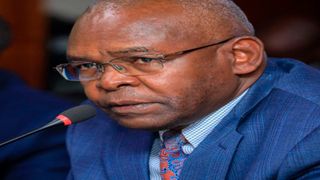
Central Bank Governor Dr Kamau Thugge on October 24, 2023. PHOTO | DENNIS ONSONGO | NMG
|Business
Premium
Bank dollar holdings rise to record Sh966.4 billion
Dollar holdings by Kenyan commercial banks have shot up by 78 percent to hit a record $6.32 billion (Sh966.4 billion) in September, as lenders stack up the units amid the dollarisation of the economy and a growing greenback black market.
The increase from $3,549.9 million (Sh543.1 billion) in a similar month last year shows the dollar shortage that Kenya has battled for the past year is starting to ease.
“Commercial banks [foreign exchange] holdings improved to $6,316.5 million in September 2023 from $3,549.9 million in September 2022,” said the National Treasury in its Quarterly Economic and Budgetary Review for the first quarter of the financial year.
This comes at a time a growing number of Kenyan traders including those dealing in electronics and real estate are resorting to quoting prices in dollars in an effort to mitigate exchange losses due to the shilling’s free fall.
Dollarisation occurs when an economy decides to use two currencies – the local currency and generally a stronger, more established currency such as the US dollar. A dollarisation process can either be partially or completely done.
The September 2022 foreign exchange holdings of banks were the lowest since July 2019, reflecting the difficulties importers and manufacturers had in accessing critical hard currencies.
A number of global shocks, starting with the Covid-19 pandemic, the war in Ukraine and the tightening of monetary policy by central banks in richer countries contributed to a capital flight in frontier and emerging markets such as Kenya with the shilling taking a hit.
By close of business on Friday, the shilling was trading at a record low of 153.23 against the dollar. The increase in dollar holdings by banks is the latest indicator that the pressure on the Kenyan unit is easing.
A Business Daily analysis shows that the shilling could finally be finding a new footing after it slowed down its monthly free fall to one percent so far in November from 4.3 percent in March, weeks after the banking sector regulator asked 10 banks to explain why they were selling dollars expensively.
A tracking of commercial dollar rates of four banks, including Equity, NCBA, I&M and Stanbic also shows that the spread— the difference between buying and selling price— has halved to a mean of 5.8 compared to 10.4 in April as it shrinks from a peak of 16 units.
Normally, traders buy foreign currencies from forex traders who include commercial banks and forex bureaus. But for most of last year, manufacturers complained they had difficulty accessing dollars to buy raw materials from the global market.
This was, however, refuted by government officials, including the former Central Bank of Kenya Governor Dr Patrick Njoroge and the then Treasury Principal Secretary Julius Muia.
Dr Muia blamed manufacturers for what he termed as an artificial shortage of dollars in the foreign exchange market following their public comments, insisting that the government had enough foreign exchange reserves to cover the country’s import needs for over five months.
“Therefore, there shouldn’t be a problem in terms of availability of the hard currency,” he said. Dr Muia told manufacturers that the shortage had been caused by their sentiments.
Dr Njoroge also laughed off the remarks of dollar shortage, noting that the foreign exchange market produces in excess of $2 billion every month.
At the time, there were concerns that the CBK, under the instruction of the International Monetary Fund (IMF), decided to stay away from the market in what was aimed at letting the exchange rate be used as a shock absorber.
Moreover, the lack of a functional foreign exchange interbank market might have resulted in the shortage even as increased demand for the dollar owing to increased prices of commodities such as fertiliser and cereals in the global market piled the pressure on the shilling.
The CBK had also published an indicative rate of 20 cents, which constrained trading in the foreign exchange market.
The reopening of the interbank dollar market in April and the removal of a CBK rule that capped daily deviation from the indicative rate at 20 cents might have helped the exchange rate find its own level through demand and supply.
This has coincided with the increase in banks’ foreign exchange reserves starting in April, allowing them to provide dollars to borrowers.
Reserves held by banks in April were $4,418.2 million (Sh676.6 billion) and have continued to rise since then.
At the start of the year, the CBK directed commercial banks to ration dollars following a shortage of the currency and the race to protect reserves.
Consequently, banks imposed a daily cap on dollar purchases of as little as $5,000 as firms struggled to obtain adequate forex to meet their supply needs.
This forced industrialists to start seeking dollars daily and from several lenders for their monthly hard currency needs as the shortage put a strain on supplier relations and the ability to negotiate favourable prices in spot markets.
The improved reserves of dollars by banks come at a time when Kenyans have increasingly been opening dollar accounts.





